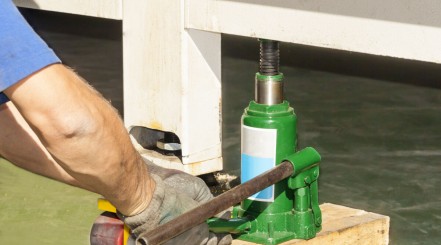how to use a bottle jack
There are many reasons why one might want a jack. Of course, if you're at our website, you probably want a jack for lifting your vehicle for maintenance.
While some jacks are used exclusively for automotive purposes, others are more versatile. The hydraulic bottle jack is one such type.
These handy jacks are also great for construction projects, such as holding up floor joists, decks, or small foundations. You can even use them for bending bars.
They work just as effectively in a horizontal position as they do vertically making them a go-anywhere jack. And they're small enough to be portable.
If you've bought, or are thinking of buying a hydraulic bottle jack for use with your vehicle, read on to learn how to use one properly and safely.
What is a Hydraulic Bottle Jack?
After the scissor jack that comes free with most cars and is incredibly easy to use, the bottle jack is the second most commonly found of all the different types of jacks available.
You've probably seen one of these, even if you didn't know what it was. It's the typical red (usually), slender, vertical jack commonly found in trunks, trailers, garages, and on construction sites.
How do Hydraulic Bottle Jacks Work?
The hydraulic jack was invented in the mid-19th century, but it was based on principles established by French scientist Blaise Pascal 200 years earlier.
Pascal discovered that exerting pressure on a fluid, which is essentially incompressible, in an enclosed space, resulted in an equal transference of that pressure in every direction.
So here's what's going on in a hydraulic jack:
Inside the jack, there's a reservoir of fluid. (It's a type of oil.) When you pull up on the handle, a portion of that fluid is drawn from the reservoir and into a small void under a small piston. Push down on the handle and the piston pushes the fluid into the main cylinder where there's a larger piston.
Each cycle of up and down forces more fluid under the large piston and increases the pressure and the cylinder. Since the pressure is equal in all directions, and since the walls of the cylinder won't move but the piston will, the piston is forced upwards and held there by the pressure underneath.
When you're ready to lower the jack, turning the release valve allows the fluid to return to the reservoir slowly. As the pressure under the central piston decreases, it gradually slides back down until it's fully retracted.
Are There Different Types of Hydraulic Bottle Jacks?
There are a wide variety of bottle jacks available, but they all work essentially the same. The biggest differences you'll notice are in lifting range and lifting capacity.
For most automotive purposes, jacks in the 2 to 12-ton range are more than enough. You can, however, find jacks rated for 100 tons or more. Typically these are used on construction sites for holding up buildings.
There are hydraulic bottle jacks that can be operated with compressed air instead of hand pumping. If you do a lot of vehicle lifting, you might enjoy having this type of jack to save yourself a lot of manual labor. They cost a bit more than a manual jack, but if you've already got a compressor, you'll appreciate the time and effort you'll save.
How to Use a Hydraulic Bottle Jack
It should go without saying that lifting a heavy object in the air and balancing it on a narrow point is dangerous.
Although a good jack is a safe jack, it's still a situation that calls for caution. The kind of injury you can sustain or damage you can cause by misusing a jack is scary.
Here are step-by-step instructions for the safe operation of a hydraulic bottle jack.
- Park your vehicle in a level place, if possible. A garage is the best choice. If it's an emergency situation try to find a level spot (if you can move your vehicle) and keep yourself clear of traffic. Set your parking brake to help prevent rollback; if the vehicle rolls while you're jacking it up it may topple the jack and come crashing down.
- Chock the wheels at the opposite end of the vehicle from where the jack will be (front wheels if you're lifting at the back; rear wheels if you're working at the front). This is another safeguard against rollback.
- If you're planning on getting underneath your vehicle, or you mean to leave it up for a prolonged period, you'll need jack stands. Get your jack stand(s) and check them for defects, making sure they're ready for use. Always use jack stands when performing maintenance under the vehicle. For detailed instructions, check out or guide: How to use jack stands.
- Inspect your jack for any flaws or damage, including leaking hydraulic oil. Ensure the plug is on tight; usually, this is on the back of the barrel. Also, make sure the release valve is closed. Wipe any debris off the saddle (the top part of the lifting cylinder) to ensure good contact with the vehicle.
- Assemble the handle and insert it into the receptacle at the side of the barrel. Make sure it's in all the way – you don't want it slipping out!
- Give the jack a few test pumps without a load. Just pump the handle slowly up and down. Let the cylinder down by turning the release valve slowly counterclockwise to make sure it's operating correctly. The handle is notched on one end; use this notch to turn the release valve. The valve is located near the bottom of the barrel on the front of the jack. Retighten the release valve.
- Find the lift point on your vehicle in the area you need to access. If you're not sure where it is, have a look in the owner's manual. Lift points are built specifically to take the pressure of a lift without bending or cracking. It's important to lift from the designated lift points to avoid damaging the vehicle.
- Check your workspace to make sure it's clear of people and debris, and anything you might hurt yourself on. Also, make sure you have enough room to work safely.
- Place your bottle jack in position as close to directly under the lift point as you can manage. If the ground is uneven, or if it's soft, placing a solid board under the jack will give you a solid, reasonably level surface to work from.
- Insert the handle and pump the jack until the saddle is almost touching the vehicle. If you need to make any small adjustments to get the saddle lined up perfectly with the lift point, now's the time.
- Pump the jack carefully until the vehicle is high enough off the ground for you to do what you need to do safely. Although good bottle jacks have safety features to prevent over-extension, it's still a good idea not to lift your vehicle any higher than you need to. Now, position your jack stand(s) so that they're ready to take the weight of the vehicle.
- Remove the handle from the jack and, using the notch you'll find at one end, turn the release valve gently counter-clockwise. This will drain the fluid from the cylinder, allowing the lifting column to descend. Very slowly let the jack down until the weight of the vehicle is on the jack stand(s). Be sure the stand(s) are holding before lowering the jack further.
- It's now safe to work on your vehicle. When you're done, repeat steps 9 to 11 until the weight is off the stand(s).
- Carefully remove the jack stands and put them out of the way, along with any tools you may have been using.
- Check to make sure there's no one still working on or under the vehicle, or standing nearby. Once you're sure it's all clear, slowly lower the vehicle until it's resting on the ground.
Final Thoughts
That's all there is to it!
Just remember that no matter how many times you lift your vehicle, and how comfortable you are with your hydraulic bottle jack, it's always important to work carefully and follow every step every time.
Lifting your car is serious business and has the potential to cause serious injury and even death if not done correctly. Take care, do it right, and have fun with your vehicle!
Thanks for reading, and best of luck with whatever your next project is!


From childhood go karting and motocross, to collecting and obsessing over scalextric, matchbox and radio controlled cars, I've always had an obsession with cars.
Learning through manuals, books, trial and error, and more knowledgeable family members, I've also enjoyed tinkering with the mechanics and electronics of any vehicles I've owned.
Now, over 3 decades later, I've started this site as a place for me to share my knowledge, to teach others how to care for and maintain their vehicles themselves, so they can get the most out of their vehicles and save a pretty penny compared to always seeking out professional help.
More From Tools
how to use a bottle jack
Source: https://www.vehiclescene.com/how-to-use-a-bottle-jack/
Posted by: hartleyhaddespeame.blogspot.com

0 Response to "how to use a bottle jack"
Post a Comment